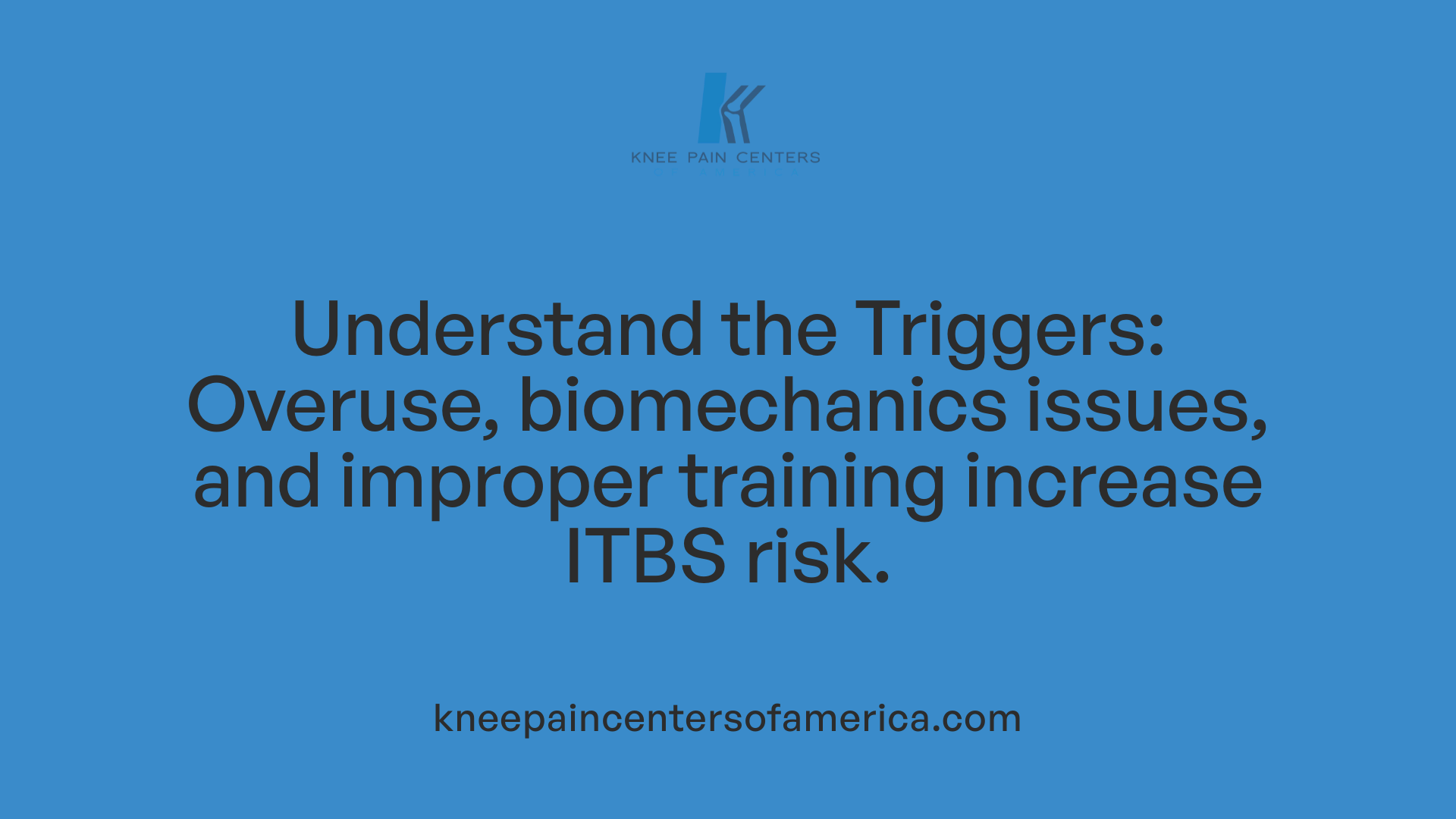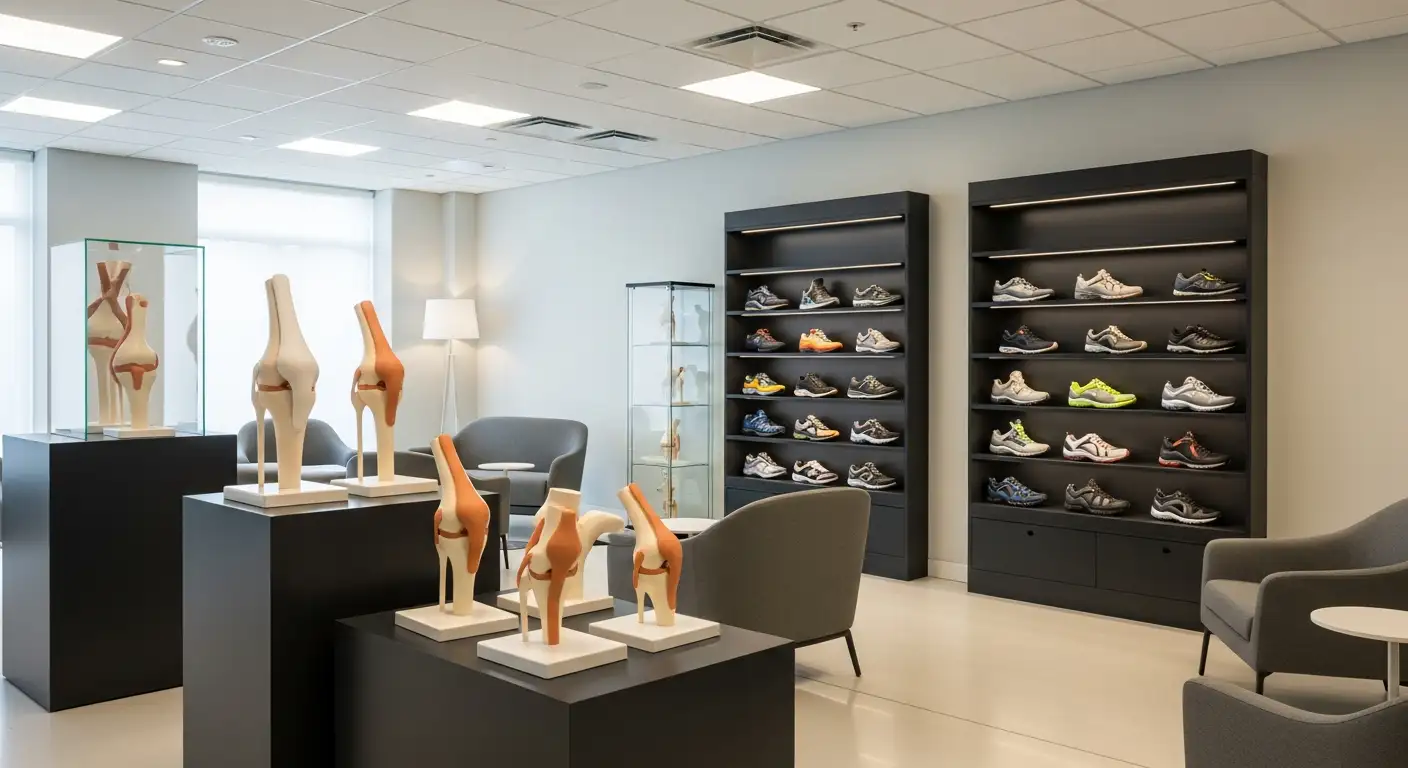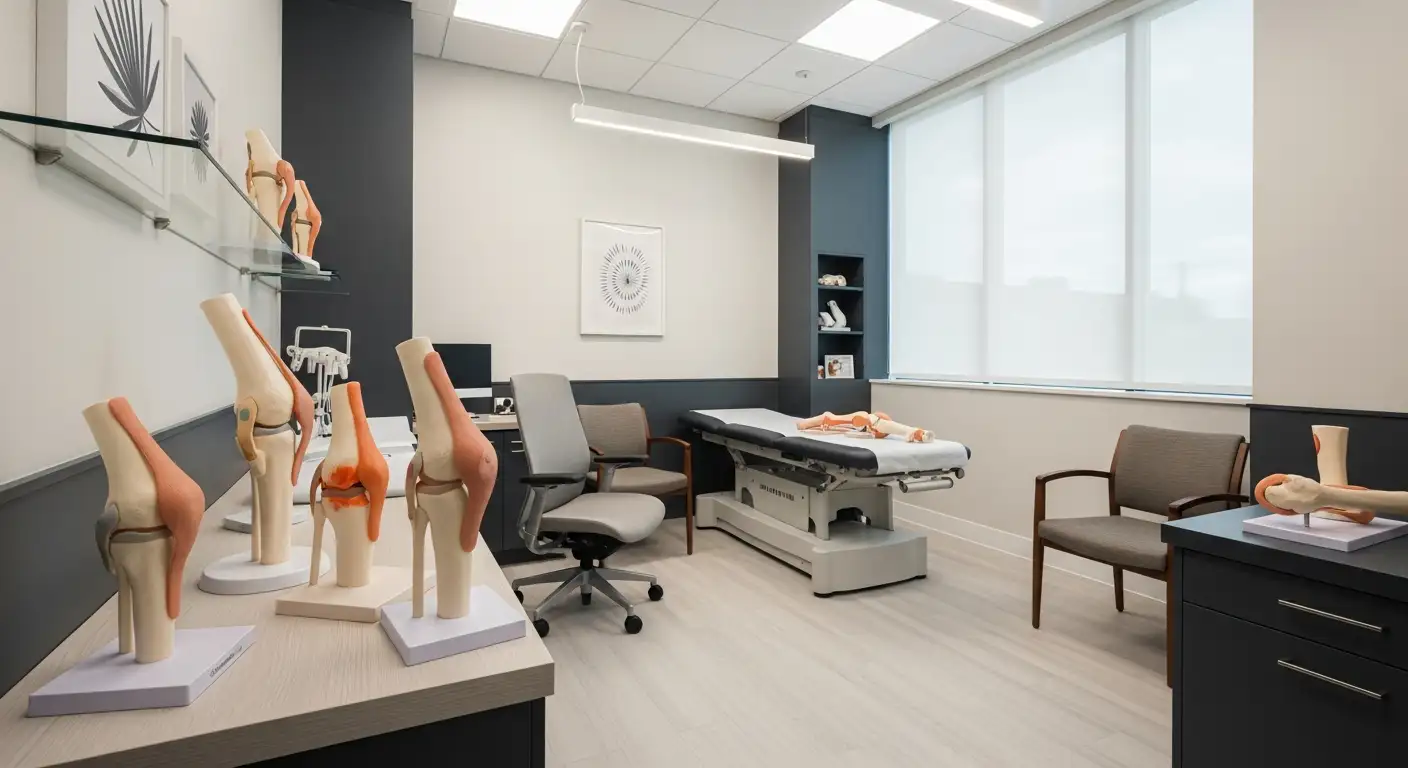Introduction to Iliotibial Band Syndrome (ITBS)
Iliotibial band syndrome (ITBS) is a common overuse injury often affecting athletes, particularly runners, cyclists, and sports enthusiasts. Recognizing its symptoms, understanding its causes, and knowing the treatment options are essential for effective recovery and prevention. This article provides an in-depth overview of ITBS, offering guidance on diagnosis, management, and strategies to prevent its occurrence.
Symptoms and Clinical Presentation of ITBS

What are the common symptoms of iliotibial (IT) band syndrome?
Individuals with IT band syndrome often experience pain on the outer side of the knee, which tends to worsen during repetitive activities like running, cycling, or walking. This pain can be described as aching, burning, or sharp, and it might also radiate upward along the thigh to the hip.
Many patients report clicking, popping, or snapping sounds when moving the knee, especially during bending or straightening. Alongside these sensations, the affected area may become tender to touch, with signs of warmth or redness indicating inflammation.
As the condition advances, the discomfort that initially appears during activity may become more persistent, uncomfortable even at rest. Swelling along the lateral knee or thigh is common if inflammation or tissue irritation occurs. Patients often mention increased sensitivity in the area in addition to visible swelling and stiffness.
In summary, the primary signs include:
- Outer knee pain that worsens with activity
- Aching, burning, or sharp sensations
- Clicks, pops, or snaps during movement
- Tenderness and warmth around the knee
- Redness and inflammation
- Pain that may spread up the thigh towards the hip
- Swelling along the outer knee or thigh
Recognizing these symptoms early, especially in athletes and active individuals, enables prompt management and decreases the likelihood of long-term discomfort.
Causes and Contributing Factors

What are the causes of iliotibial (IT) band syndrome?
Iliotibial (IT) band syndrome is mainly caused by overuse and repetitive movements that involve bending and extending the knee. This is especially common in athletes who engage in activities such as running, cycling, skiing, and long-distance walking. During these activities, the IT band, which runs along the outside of the thigh from the hip to the knee, can rub against bony prominences or inflamed bursae beneath it.
This rubbing creates mechanical friction that leads to irritation, inflammation, and sometimes swelling of the tissues around the band. Several factors can contribute to this process. Tightness in the IT band itself or imbalance in the muscles that support the hip and thigh can increase tension and friction.
In addition, natural anatomical variations such as leg length discrepancies, bowed legs, or misalignment in the hips or knees can predispose individuals to IT band problems. Improper biomechanics, like overpronation or excessive inward rotation of the foot and leg, may also play a role.
Training errors are significant contributors. Sudden increases in activity intensity or volume, running on uneven or inclined surfaces, and failing to warm up properly can all elevate the risk. Wearing inappropriate or worn-out footwear can further exacerbate biomechanical issues.
In summary, IT band syndrome results from a combination of mechanical friction, inflammation, repetitive stress, and individual anatomical or biomechanical susceptibilities. Recognizing these causes helps in designing effective prevention and treatment strategies.
Diagnosis and Clinical Assessment
 How is iliotibial (IT) band syndrome diagnosed?
How is iliotibial (IT) band syndrome diagnosed?
The diagnosis of iliotibial (IT) band syndrome starts with a detailed medical history and a physical exam. Patients typically report pain on the outer side of the knee that worsens with activity, especially during running, cycling, or climbing stairs.
During the physical examination, healthcare providers look for tenderness over the lateral femoral epicondyle, which is a common site affected by inflammation. They also perform specific provocative tests to assess IT band tightness and irritation:
- Ober Test: Checks for tightness of the IT band by having the patient lie on their side and abduct the leg; a positive test indicates limited hip adduction.
- Renne Test: Assesses for pain during compression of the IT band over the lateral epicondyle.
- Noble's Test: Involves applying pressure over the lateral femoral condyle while passively flexing and extending the knee; pain at around 30° of flexion suggests IT band friction.
In certain cases, especially when symptoms persist despite conservative treatment, imaging studies like MRI or ultrasound can be useful. These scans help visualize thickening of the IT band or inflammation of the bursa, and they are helpful to exclude other conditions such as meniscal tears or stress fractures.
Overall, straightforward physical assessment combined with patient history usually suffices to diagnose IT band syndrome. Imaging is reserved for ambiguous cases or when ruling out other injuries.
Additional Details
| Diagnostic Method | Purpose | Notes |
|---|---|---|
| Medical history & physical exam | Initial assessment | Focus on activity pain, tenderness, and functional limitations |
| Tenderness testing | Localize inflammation | Tender over lateral epicondyle, pain during movement |
| Provocative tests (Ober, Renne, Noble's) | Confirm IT band involvement | Specific tests to assess tightness and friction |
| MRI or Ultrasound | Confirm diagnosis | Visualize tissue thickening, rule out other injuries |
| Differential diagnosis | Exclude other causes | Runner's knee, stress fractures, meniscal tears |
This comprehensive approach ensures accurate diagnosis and guides appropriate treatment strategies.
Search query: Diagnosing IT band syndrome in athletes
Conventional Treatment Modalities for ITBS
Treatment options for iliotibial (IT) band syndrome primarily involve conservative measures aimed at reducing inflammation and facilitating healing. The first step often includes rest from activities that provoke symptoms, such as running or cycling, along with activity modification to avoid aggravating the condition.
Nonsteroidal anti-inflammatory drugs (NSAIDs), like Ibuprofen and Naproxen, are commonly used to alleviate pain, reduce swelling, and manage inflammation. Alongside medication, physical therapy plays a vital role. This includes targeted stretching exercises to improve flexibility of the IT band and surrounding tissues, as well as strengthening exercises to bolster the hip abductors, glutes, and core muscles, which contribute to better joint stability.
Manual therapy techniques such as foam rolling, massage, and deep tissue manipulations help release tension in the IT band and associated muscle groups. Foam rolling, in particular, is a popular self-myofascial release method that can decrease tightness and improve tissue mobility.
In cases where pain persists despite these conservative measures, corticosteroid injections can be administered to reduce severe inflammation and provide symptomatic relief. These injections are typically used judiciously due to their potential side effects.
Addressing biomechanical issues and training habits is also crucial. Adjustments may include optimizing running gait, proper footwear selection, and correcting structural imbalances like leg-length discrepancies. For most individuals, these interventions lead to significant improvement within several weeks to a few months.
Surgery remains a last resort option, recommended only if nonoperative treatments fail over a period of around 6 months. Surgical procedures may involve releasing or lengthening the IT band or removing inflamed bursal tissue for alleviating friction.
Overall, a comprehensive and personalized approach combining activity management, therapy techniques, and biomechanical corrections offers the best prognosis for recovery from IT band syndrome, with many patients returning to their regular activities around 2 to 8 weeks after starting treatment.
Non-Surgical Management and Rehabilitation
Managing iliotibial (IT) band syndrome without surgery involves a combination of strategies aimed at reducing inflammation, restoring normal movement, and strengthening affected muscles.
The first step typically includes rest and activity modification. It is important to avoid activities that cause pain, such as running or cycling, to give the inflamed tissue time to heal. Applying ice to the affected area can help decrease swelling and soothe pain, especially after activity.
Anti-inflammatory medications like NSAIDs (non-steroidal anti-inflammatory drugs) are commonly used to manage inflammation and discomfort. These drugs should be used as directed and in consultation with a healthcare provider.
Physical therapy is a cornerstone of conservative treatment, focusing on specific stretching and strengthening exercises. Stretching tight muscles such as the iliotibial band, hip abductors, and leg muscles helps improve flexibility. Strengthening weak muscles around the hips and core can improve biomechanics and reduce stress on the IT band.
Manual therapies, including foam rolling, deep tissue massage, and myofascial release, are often employed to alleviate tension in the IT band and surrounding tissues. While these techniques can provide relief, their long-term effectiveness varies among individuals.
Supportive devices like orthotics or properly fitted footwear may assist in correcting biomechanical issues such as overpronation, which can contribute to ITBS. Gait and movement retraining, often guided by physical therapists, help modify running or walking mechanics to prevent aggravation.
If conservative approaches do not resolve symptoms, corticosteroid injections may be considered to reduce persistent inflammation and provide relief. Surgery remains a last resort for cases that persist beyond six months despite diligent non-surgical interventions.
In summary, a tailored combination of rest, anti-inflammatory measures, targeted physical therapy, manual therapies, and movement correction typically yields successful outcomes, with most individuals experiencing significant improvement within several weeks to months.
Prevention and Education for Athletes and Runners

What prevention strategies can help avoid iliotibial (IT) band syndrome?
Preventing IT band syndrome involves a combination of proper training habits, exercises, and assessments. Athletes and runners should begin each workout with dynamic warm-up routines that include stretching targeted at the hips, thighs, and hamstrings. This prepares muscles and tendons for activity and reduces injury risk.
Gradually increasing training intensity and volume—no more than 10% per week—is crucial to avoid overload. Adequate rest and recovery days allow tissues to heal and adapt, decreasing the likelihood of inflammation.
Strengthening the muscles that support the pelvis, hips, and knees plays a vital role in prevention. Focused exercises to build the hip abductors, glutes, core muscles, and quadriceps help support proper biomechanics and reduce stress on the IT band.
Supportive footwear is essential, and replacing worn-out shoes regularly ensures proper cushioning and support. Running or cycling on even, softer surfaces can also lessen the repetitive stress that causes irritation.
Proper movement technique, including appropriate running form and cycling posture, can prevent abnormal friction. Cross-training with low-impact activities like swimming or elliptical training offers alternatives that reduce joint stress while maintaining cardiovascular fitness.
Finally, incorporating regular stretching of the outer thigh, IT band, and hamstring muscles maintains flexibility and reduces tightness, which is often a contributing factor.
Recognizing early symptoms such as mild discomfort or stiffness allows for prompt rest and treatment, preventing progression. Education on these preventive measures is essential for athletes aiming to stay injury-free and maintain peak performance.
Education and Self-Management for Athletes
Recognizing the early signs of iliotibial (IT) band syndrome is crucial for athletes and runners to prevent more serious injury. Common symptoms include pain on the outside of the knee or hip, clicking or snapping sensations during movement, and increased discomfort after repetitive activities like running or cycling. Becoming familiar with these signs allows athletes to seek prompt care and modify their activity before the condition worsens.
Understanding the causes of IT band syndrome helps in maintaining healthy training habits. Overuse from sudden increases in activity, poor biomechanics such as inward foot rotation, tightness of the IT band, and inadequate rest are typical contributors. Factors like running on uneven surfaces, improper footwear, and muscle imbalances—especially weak hip and core muscles—can also predispose athletes to injury.
Incorporating preventive exercises and stretches into regular training routines can significantly reduce the risk. Exercises that strengthen the hip abductors, gluteal muscles, and core, along with stretching of the outer thigh and hamstring muscles, are recommended. Proper warm-up and cool-down sessions, along with routine use of foam rollers, help maintain flexibility and tissue health.
Seeking medical evaluation promptly is important if symptoms persist despite self-care. Professionals such as sports medicine doctors, physiotherapists, or osteopaths can perform thorough assessments and recommend tailored treatment plans. Early intervention often leads to better outcomes and quicker return to activity.
Adopting proper training techniques and wearing supportive footwear also contribute to prevention. Athletes should gradually increase training intensity, avoid sudden mileage jumps, run on even surfaces, and ensure their shoes provide adequate support and cushioning.
Finally, rest and gradual progression are vital components of injury management. Allowing time for healing and avoiding overexertion helps prevent recurrence. Educating oneself continuously—through reputable sources, professional advice, and ongoing self-awareness—empowers athletes to manage and prevent IT band syndrome effectively.
For further details, searching "Self-education on IT band syndrome in athletes" can provide comprehensive online resources to support knowledge enhancement and injury prevention strategies.
Exercises and Activity Modifications for Recovery
 When recovering from iliotibial (IT) band syndrome, it is essential to adopt appropriate exercises and activity modifications to reduce irritation and promote healing.
When recovering from iliotibial (IT) band syndrome, it is essential to adopt appropriate exercises and activity modifications to reduce irritation and promote healing.
Gentle stretching routines are beneficial during this phase. Exercises such as standing iliotibial band stretch, pigeon pose, and supine crossover are effective in improving flexibility without putting excessive strain on the IT band. These stretches help loosen tight muscles around the hip and thigh, alleviating tension that contributes to IT band irritation.
Conversely, activities that involve repetitive knee bending and straightening, like squats, lunges, and leg extensions, should be avoided. Such movements can increase tension and friction on the IT band, potentially worsening symptoms. Similarly, high-impact activities such as long-distance running, walking on uneven terrain, or jumping should be limited until symptoms improve.
Focusing on strengthening the muscles that support the hip and outer thigh is also crucial. Exercises targeting the gluteus medius and gluteus maximus, like side-lying leg lifts or slow, controlled hip abduction movements, can enhance stability. Strengthening these muscles reduces strain on the IT band during activity.
Progression should be gradual. Initially, emphasize stretching and low-impact strengthening exercises. As symptoms diminish, gradually reintroduce more dynamic movements while monitoring for any signs of irritation.
In conclusion, effective recovery involves avoiding aggravating activities, incorporating gentle stretches, and strengthening supportive muscles. Consulting with a physical therapist can provide tailored guidance. Search terms like "Exercises for IT band syndrome recovery" can offer further practical routines for a safe and efficient rehabilitation.
Summary and Final Recommendations
While iliotibial band syndrome can cause significant discomfort and affect athletic performance, early recognition and appropriate management are key to successful recovery. Most cases respond well to conservative treatments, including activity modification, targeted physical therapy, and preventive measures. Understanding the causes and symptoms helps in prompt diagnosis, while adherence to treatment and prevention strategies minimizes the risk of recurrence. Athletes should prioritize gradual training, proper equipment, and maintaining flexibility and strength in surrounding muscles. Consulting healthcare professionals for personalized care ensures effective healing and return to activity. With proper care and awareness, individuals can manage ITBS effectively and enjoy continued participation in their preferred sports.
References
- Iliotibial Band Syndrome (ITBS): Causes, Symptoms & Treatment
- Iliotibial Band Syndrome | Johns Hopkins Medicine
- IT Band Syndrome: Knee Pain Symptoms & Treatments - HSS
- How to Identify and Treat Iliotibial Band Syndrome
- IT Band Syndrome: Symptoms, Treatment & Prevention
- IT Band Syndrome Symptoms & Treatment - Aurora Health Care
- Iliotibial (IT) Band Syndrome: Causes, Symptoms, Treatment - WebMD





